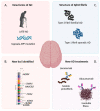The Breakthroughs and Caveats of Using Human Pluripotent Stem Cells in Modeling Alzheimer's Disease
- PMID: 36766763
- PMCID: PMC9913971
- DOI: 10.3390/cells12030420
The Breakthroughs and Caveats of Using Human Pluripotent Stem Cells in Modeling Alzheimer's Disease
Abstract
Modeling Alzheimer's disease (AD) using human-induced pluripotent stem cells (iPSCs) is a field now spanning 15 years. Developments in the field have shown a shift in using simple 2D cortical neuron models to more advanced tri-cultures and 3D cerebral organoids that recapitulate more features of the disease. This is largely due to development and optimization of new cell protocols. In this review, we highlight recent major breakthroughs in the AD field and the implications this has in modeling AD using iPSCs (AD-iPSCs). To date, AD-iPSCs have been largely used to recapitulate and study impaired amyloid precursor protein (APP) processing and tau phosphorylation in both familial and sporadic AD. AD-iPSCs have also been studied for varying neuronal and glial dysfunctions. Moreover, they have been useful for discovering new molecular mechanisms, such as identifying proteins that bridge APP processing with tau phosphorylation and for identifying molecular pathways that bridge APP processing dysfunction with impaired cholesterol biosynthesis. Perhaps the greatest use of AD-iPSCs has been in discovering compounds via drug screening, that reduce amyloid beta (Aβ) in neurons, such as the anti-inflammatory compound, cromolyn, and antiparasitic drugs, avermectins. In addition, high content screening using AD-iPSCs has led to the identification of statins that can reduce levels of phosphorylated tau (p-Tau) in neurons. Some of these compounds have made it through to testing in human clinical trials. Improvements in omic technologies including single cell RNA sequencing and proteomics as well as advances in production of iPSC-cerebral organoids and tri-cultures is likely to result in the further discovery of new drugs and treatments for AD. Some caveats remain in the field, including, long experimental conditions to create mature neurons, high costs of media that limit research capabilities, and a lack of reproducibility using current iPSC-cerebral organoid protocols. Despite these current limitations, AD-iPSCs remain an excellent cellular model for studying AD mechanisms and for drug discovery.
Keywords: APP processing; Alzheimer’s disease; astrocytes; disease modelling; drug discovery; induced pluripotent stem cells; microglia; neurons; tau phosphorylation.
Conflict of interest statement
The authors declare no conflict of interest.
Figures



Similar articles
-
Neurons derived from sporadic Alzheimer's disease iPSCs reveal elevated TAU hyperphosphorylation, increased amyloid levels, and GSK3B activation.Alzheimers Res Ther. 2017 Dec 1;9(1):90. doi: 10.1186/s13195-017-0317-z. Alzheimers Res Ther. 2017. PMID: 29191219 Free PMC article.
-
Probing sporadic and familial Alzheimer's disease using induced pluripotent stem cells.Nature. 2012 Jan 25;482(7384):216-20. doi: 10.1038/nature10821. Nature. 2012. PMID: 22278060 Free PMC article.
-
Modeling Alzheimer's Disease by Induced Pluripotent Stem Cells Carrying APP D678H Mutation.Mol Neurobiol. 2019 Jun;56(6):3972-3983. doi: 10.1007/s12035-018-1336-x. Epub 2018 Sep 20. Mol Neurobiol. 2019. PMID: 30238389 Free PMC article.
-
Human Pluripotent Stem Cell-Derived Neural Cells as a Relevant Platform for Drug Screening in Alzheimer's Disease.Int J Mol Sci. 2020 Sep 18;21(18):6867. doi: 10.3390/ijms21186867. Int J Mol Sci. 2020. PMID: 32962164 Free PMC article. Review.
-
Modelling Sporadic Alzheimer's Disease Using Induced Pluripotent Stem Cells.Neurochem Res. 2018 Dec;43(12):2179-2198. doi: 10.1007/s11064-018-2663-z. Epub 2018 Nov 1. Neurochem Res. 2018. PMID: 30387070 Free PMC article. Review.
Cited by
-
The probable role of tissue plasminogen activator/neuroserpin axis in Alzheimer's disease: a new perspective.Acta Neurol Belg. 2024 Apr;124(2):377-388. doi: 10.1007/s13760-023-02403-x. Epub 2023 Nov 2. Acta Neurol Belg. 2024. PMID: 37917293 Free PMC article. Review.
-
Development of brain organoid technology derived from iPSC for the neurodegenerative disease modelling: a glance through.Front Mol Neurosci. 2023 Aug 3;16:1173433. doi: 10.3389/fnmol.2023.1173433. eCollection 2023. Front Mol Neurosci. 2023. PMID: 37602192 Free PMC article. Review.
-
Recent Research Trends in Neuroinflammatory and Neurodegenerative Disorders.Cells. 2024 Mar 14;13(6):511. doi: 10.3390/cells13060511. Cells. 2024. PMID: 38534355 Free PMC article. Review.
-
Induced Pluripotent Stem Cells-Based Regenerative Therapies in Treating Human Aging-Related Functional Decline and Diseases.Cells. 2025 Apr 21;14(8):619. doi: 10.3390/cells14080619. Cells. 2025. PMID: 40277944 Free PMC article. Review.
-
Urine-derived cells from the aged donor for the 2D/3D modeling of neural cells via iPSCs.Aging Brain. 2023 Nov 19;4:100101. doi: 10.1016/j.nbas.2023.100101. eCollection 2023. Aging Brain. 2023. PMID: 38045491 Free PMC article.
References
-
- Nelson P.T., Dickson D.W., Trojanowski J.Q., Jack C.R., Boyle P.A., Arfanakis K., Rademakers R., Alafuzoff I., Attems J., Brayne C., et al. Limbic-predominant age-related TDP-43 encephalopathy (LATE): Consensus working group report. Brain. 2019;142:1503–1527. doi: 10.1093/brain/awz099. - DOI - PMC - PubMed
-
- de la Vega M.P., Giedraitis V., Michno W., Kilander L., Güner G., Zielinski M., Löwenmark M., Brundin R., Danfors T., Söderberg L., et al. The Uppsala APP deletion causes early onset autosomal dominant Alzheimer’s disease by altering APP processing and increasing amyloid beta fibril formation. Sci. Transl. Med. 2021;13:eabc6184. doi: 10.1126/scitranslmed.abc6184. - DOI - PubMed
-
- Wightman D.P., Jansen I.E., Savage J.E., Shadrin A.A., Bahrami S., Holland D., Rongve A., Børte S., Winsvold B.S., Drange O.K., et al. A genome-wide association study with 1,126,563 individuals identifies new risk loci for Alzheimer’s disease. Nat. Genet. 2021;53:1276–1282. doi: 10.1038/s41588-021-00921-z. - DOI - PMC - PubMed
Publication types
MeSH terms
Substances
LinkOut - more resources
Full Text Sources
Medical

